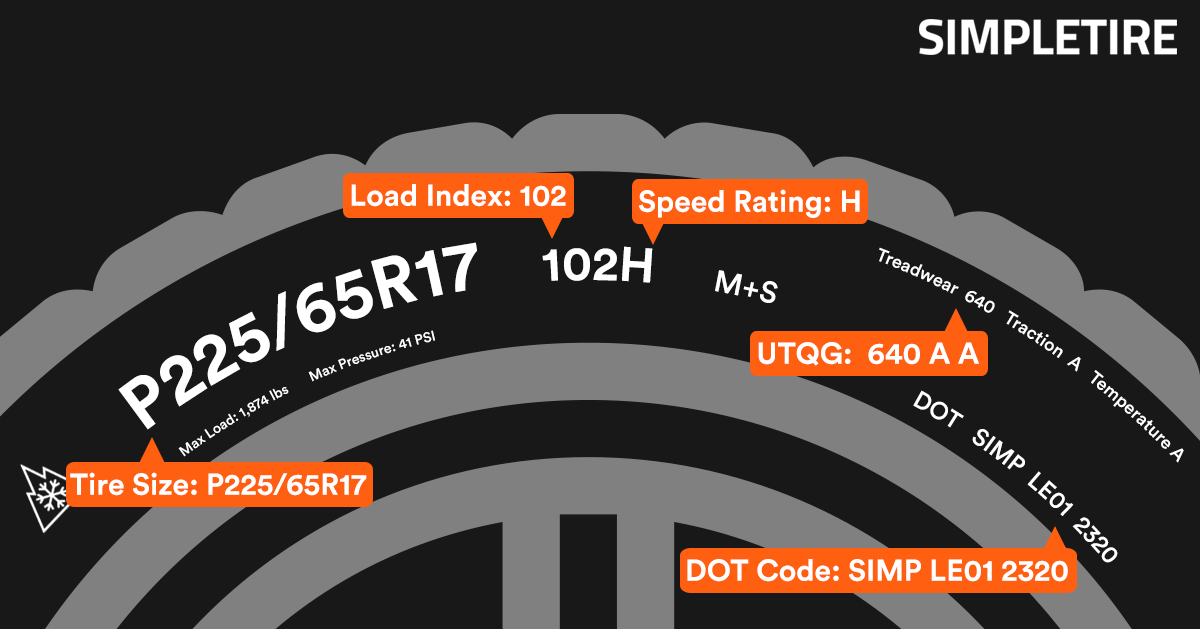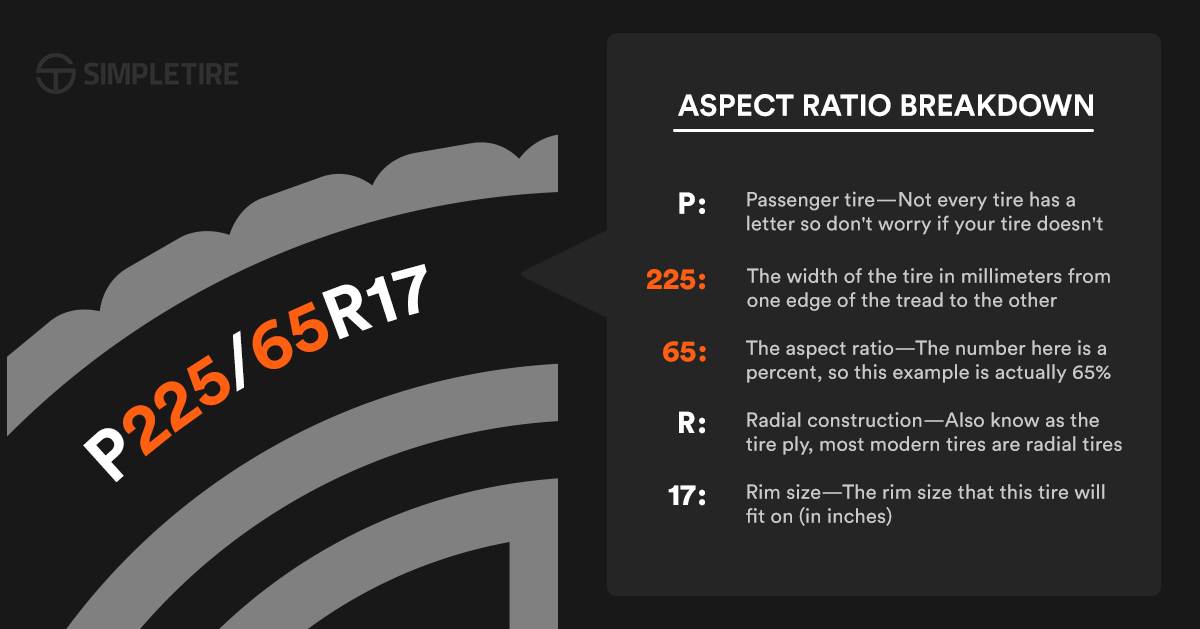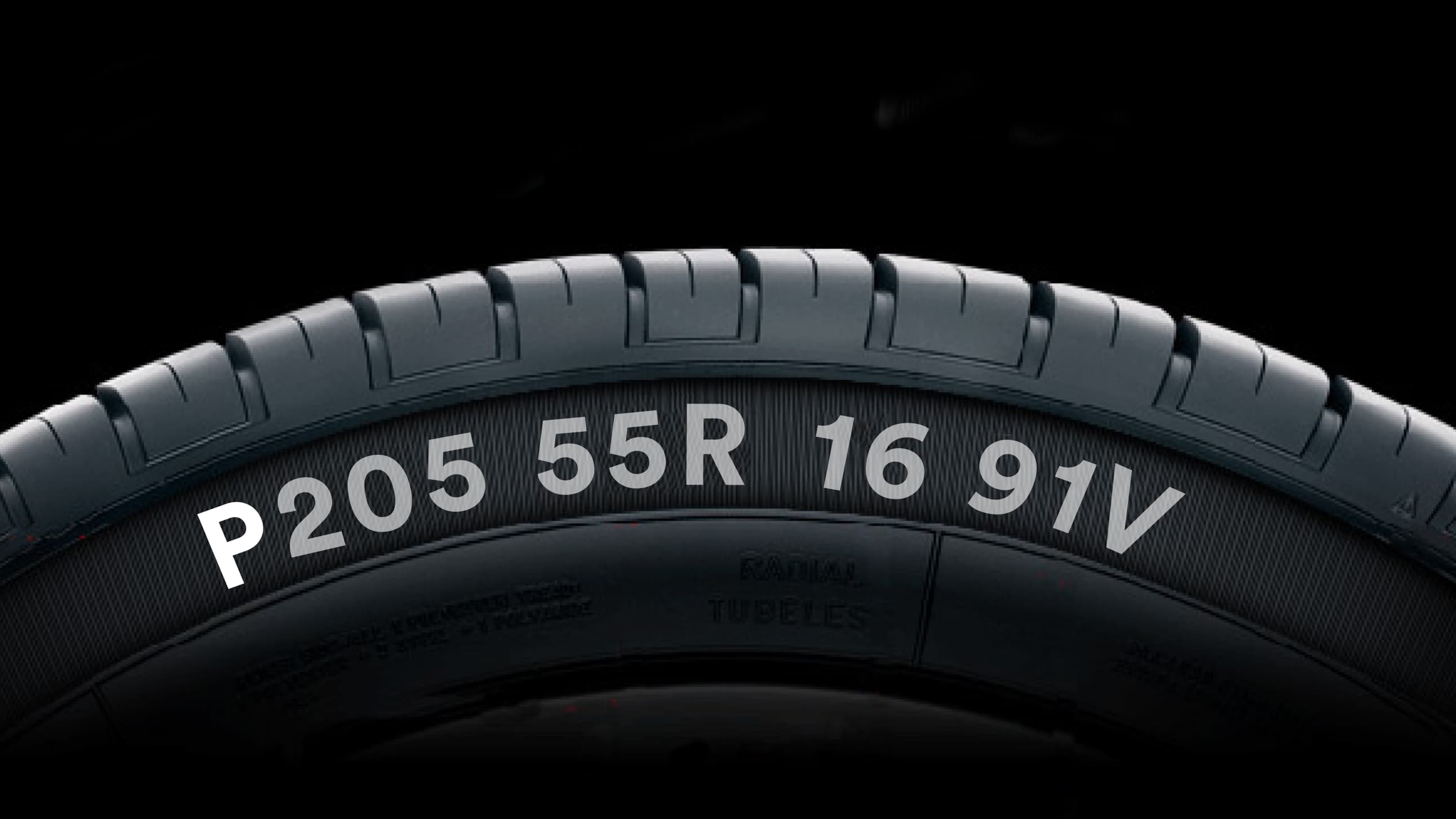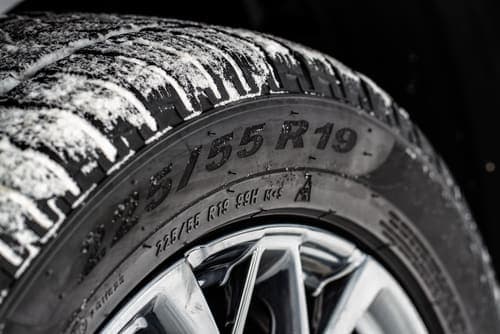Tire Buying Guides
Free shipping
Best price guarantee
Special pricing
Financing with Resolve
Easy returns

Every tire displays a series of numbers and letters on its sidewall that serve as a detailed identification code. These markings contain vital information about the tire's size, construction, and performance capabilities.
Understanding this tire code helps drivers make informed decisions about replacement tires and ensures proper vehicle safety. The standardized system makes it easy to compare different tire options and verify compatibility with your vehicle.
Learning to decode these numbers takes just a few minutes, yet this knowledge proves invaluable when shopping for new tires or checking if your current tires meet your vehicle's requirements. Each element in the code tells a specific story about what the tire can do.
What Do Tire Numbers Mean?

Tire numbers form a special code on your tire's sidewall that reveals essential information about specifications and capabilities. This alphanumeric sequence follows a universal system that all tire manufacturers use — making it simple to understand once you know what each part represents.
These numbers help you understand three critical aspects: your tire's physical dimensions, its construction type, and its performance limits. Every passenger vehicle, light truck, and trailer tire carries this standardized code, which serves as a blueprint for proper tire selection. The code typically appears as the largest set of numbers and letters on the sidewall, such as P215/65R15 95H.
Breaking down this code reveals seven distinct pieces of information. First comes the tire type designation, followed by the width measurement, aspect ratio, construction method, wheel diameter, load capacity index, and finally the speed rating. Each component plays a crucial role in determining whether a tire fits your vehicle and meets your driving needs.
Understanding tire specifications becomes particularly important when replacing tires. The wrong size can affect everything from speedometer accuracy to brake system performance. Modern vehicles rely on precise tire dimensions for proper operation of safety systems like anti-lock brakes and electronic stability control. Even a small deviation from the recommended size can trigger warning lights or cause these systems to malfunction.
Where to Find Tire Numbers on Your Vehicle
Finding the numbers on your tire is simple—they are etched into the sidewall of each tire. This sequence stands out due to its prominence and size, often being the most visible text on the tire. These codes reveal crucial details about the tire's dimensions, construction, and limits.
Beyond the tire sidewall, your vehicle owner’s manual is another key resource. It includes detailed guidance on the appropriate tire sizes tailored to your vehicle's design. This manual is essential for understanding the manufacturer's recommendations for tire specifications.
The driver’s side door jamb also holds valuable information. A sticker affixed here provides a snapshot of tire data, including size, pressure, and occasionally, load limits. This ensures you're aligning with the manufacturer’s guidelines for optimal performance.
The spare tire in your vehicle is marked with similar codes, ensuring it matches your primary tires. This consistency is vital for maintaining balanced handling and safety, especially in situations requiring a tire change.
Breaking Down Each Part of the Tire Code
Tire Type Letter
The first letter in the tire code indicates the tire's classification and its primary use. P designates tires for passenger vehicles, covering cars, minivans, and smaller SUVs. LT is used for light trucks, which include heavy-duty pickups and larger SUVs designed for towing and hauling. ST signifies special trailer tires, specifically made for trailers. A T marks temporary spare tires. If no letter appears, the tire is typically a European metric type, which may offer different load capacities.
Tire Width
Directly following the tire type letter, the three-digit number specifies the tire's width, measured in millimeters. This dimension spans from one sidewall to the other. For instance, a 215 marking shows a width of 215 millimeters. Wider tires often improve traction and stability, though they can increase fuel usage. The width is crucial in determining how the tire interacts with the road surface, impacting grip and handling.
Aspect Ratio
The aspect ratio consists of two numbers following a slash, indicating the sidewall height as a percentage of the tire's width. A higher number suggests a taller profile, which affects both comfort and performance. For example, an aspect ratio of 65 means the sidewall height is 65% of the width. Choosing the correct aspect ratio ensures your vehicle maintains optimal handling, especially during turns and stops.
Construction Type
This letter reveals how the tire is constructed internally. R stands for radial construction, where layers extend radially across the tire, enhancing fuel efficiency and tread longevity. D refers to diagonal or bias-ply construction, while B represents belted bias tires. Radial tires dominate the market today, valued for their smoother ride and durability enhancements.
Wheel Diameter
The final numbers indicate the wheel diameter in inches, signifying the rim size the tire fits. For example, a notation of 15 means the tire suits a 15-inch rim. Ensuring this matches your vehicle's wheels is vital for safety and performance. Proper alignment with the wheel size ensures optimal handling and prevents issues such as rubbing against the vehicle's structure or suspension system.
Understanding Load Index and Speed Rating
Load Index
The load index is a numerical value that indicates the maximum weight each tire can support. Represented by two or three digits, this index allows you to determine whether a tire can handle your vehicle’s load requirements. For instance, a load index of 95 corresponds to a maximum load capacity of 1,521 pounds per tire. It’s essential to select tires that match or exceed your vehicle’s load specifications to ensure safety and performance, particularly when carrying passengers and cargo.
Choosing the correct load index prevents overloading, which can lead to excessive tire wear and potential failure. Each vehicle requires tires capable of supporting its weight and any additional loads without compromising stability. Always consult your vehicle documentation or a professional to confirm the appropriate load index.
Speed Rating
The speed rating, denoted by a letter, indicates the top speed a tire can safely maintain. This rating is crucial for ensuring that tires perform reliably at different speeds. Common speed ratings include S for speeds up to 112 mph, H for up to 130 mph, and V for up to 149 mph. These ratings reflect the tire's ability to manage the heat and stress associated with higher speeds.
Selecting a speed rating that meets or exceeds your vehicle’s requirements is vital for maintaining safe driving conditions. Exceeding a tire's speed rating can affect the tire's performance and safety, potentially leading to handling issues. The speed rating should align with your vehicle’s capabilities to ensure the best performance and safety under various driving conditions.
Why Tire Size Matters for Your Vehicle

Choosing the correct tire size is crucial for maintaining the performance and safety of your vehicle. Tire size impacts several key areas of vehicle dynamics and functionality. A mismatch in tire size can lead to complications that affect overall vehicle operation and safety systems.
One key impact of incorrect tire size is on your vehicle's speedometer readings. The speedometer calculates speed based on the tire's rotations, so any deviation from the original tire size can result in inaccurate speed readings. Smaller tires may cause the speedometer to display a higher speed than actual, while larger tires may show a lower speed. This discrepancy can lead to speeding violations or unsafe driving if not addressed.
Incorrect tire sizes can also cause physical interference with the vehicle's structure. Oversized tires may rub against the wheel wells or suspension components, especially during turns or under load, leading to potential damage. This friction can wear down the tire and cause structural damage to the vehicle, resulting in costly repairs. Ensuring the correct size prevents these issues and maintains the integrity of the vehicle's components.
Moreover, the right tire size is essential for maintaining optimal handling and braking performance. Tires play a crucial role alongside the vehicle’s suspension system to deliver stability and effective braking. A tire that deviates from the recommended width or profile can alter the contact patch with the road, impacting grip and stopping power. Such changes can compromise safety, especially during emergency maneuvers. Properly sized tires work harmoniously with your vehicle's systems to ensure safe and predictable handling.
Mismatch in tire sizes can also lead to uneven tire wear and reduced fuel efficiency. Tires that do not align with the vehicle’s design parameters tend to wear unevenly, reducing their lifespan and leading to frequent replacements. Additionally, incorrect tire sizes can increase rolling resistance, which in turn demands more energy from the engine, increasing fuel consumption. This inefficiency not only impacts fuel economy but also contributes to higher emissions and increased running costs over time.
Common Tire Size Examples and What They Mean
Understanding tire size examples provides clarity on how each element influences performance and compatibility. Let’s delve into some common configurations to see the unique characteristics they offer.
P225/60R16 97T
This tire size is a practical choice for many sedans and smaller SUVs, offering a harmonious blend of comfort and efficiency. The P indicates it’s suited for passenger vehicles, accommodating day-to-day travel needs. A width of 225mm ensures balanced handling and grip, making it effective for urban and highway settings. With a 60% aspect ratio, the sidewall height supports a smooth ride, cushioning against road imperfections. R stands for radial construction, enhancing longevity and even tread wear. The 16-inch wheel diameter is designed to match most standard rims for these vehicles. A load index of 97 indicates a capacity of 1,609 pounds, providing ample support for passengers and cargo. The T speed rating is optimal for speeds up to 118 mph, aligning with regular driving conditions.
LT275/70R18 125/122S
Ideal for heavier vehicles like trucks and large SUVs, this size supports demanding tasks. LT designates its use for light trucks, offering durability for towing and off-road adventures. The width of 275mm offers enhanced stability and traction, crucial for maintaining control with heavy loads. A 70% aspect ratio gives the tire a robust profile, aiding in shock absorption over rugged terrain. Radial construction, noted by R, ensures resilience and performance consistency. The 18-inch diameter fits larger rims typical of trucks, reinforcing their rugged capabilities. The load index of 125/122 means robust weight capacity, supporting demanding applications. S speed rating permits speeds up to 112 mph, balancing strength with reliable road performance.
195/65R15 91H
This configuration is common among compact cars, offering a balance of efficiency and performance. Without a preceding letter, it follows a European metric pattern. The 195mm width provides nimble handling, making it suitable for city driving. With a 65% aspect ratio, the sidewall aids in comfort and control, particularly in urban environments. Radial construction, indicated by R, ensures durability and a smooth ride. A 15-inch diameter aligns with typical compact car rims, facilitating an efficient fit. The load index of 91 supports moderate weight, ensuring safety and stability. H speed rating allows for speeds up to 130 mph, catering to both city commutes and highway journeys.
These examples illustrate how each component of a tire's size contributes to its overall function and suitability. Understanding these specifics empowers you to choose the right tire for your needs.
How to Use Tire Numbers When Shopping for New Tires

Shopping for new tires requires a clear understanding of tire numbers, which ensures compatibility with your vehicle's specifications. Begin by identifying the appropriate category for your vehicle—whether it requires tires for passenger vehicles or those designed for heavier workloads. This ensures your new tires will support the vehicle's intended usage, from regular city commutes to more demanding tasks.
When considering tire dimensions, assess potential changes in width and profile that could affect your driving experience. Opting for a slightly wider tire can improve grip on the road, but it's important to stay within a range that complements your vehicle's design for optimal handling and fuel economy. Keep in mind that the wheel diameter must remain consistent with your current wheels, as this determines the tire's fitment on the rim.
Focus on selecting tires with the correct load capacity and speed capability to match your vehicle's demands. This ensures the tires can safely support both the vehicle's weight and the speeds at which you typically travel. Choose a speed capability that aligns with your driving patterns, whether primarily urban or more varied. Utilize online tools and resources for visualizing how different tire sizes may fit your vehicle, helping you make informed choices without guesswork.
Now that you understand what tire numbers mean, you can confidently identify the right tires for your vehicle and driving needs. These specifications ensure optimal safety, performance, and compatibility with your car's systems. When you're ready to put this knowledge into practice, we make it easy to shop for tires online and find the best deals with our extensive selection and expert guidance to help you find the perfect match.
Ready to find the perfect tires?
Search By